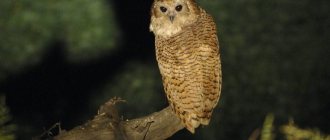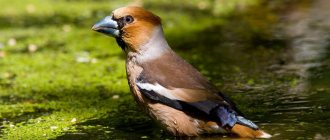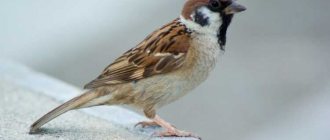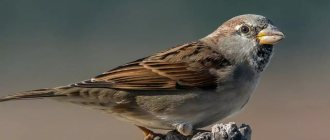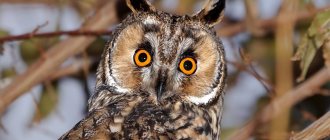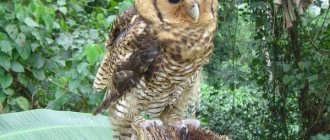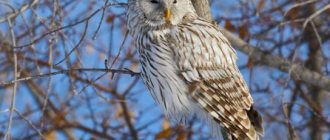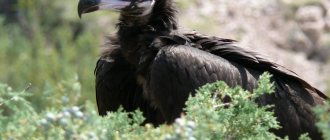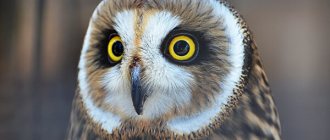Review author: “ZooVita”
Owls are amazing birds. Due to their characteristic features, they were classified by scientists as a separate species, “owls.” Due to their predominantly nocturnal lifestyle and the peculiar sounds made by owls, popular rumor has endowed owls with various unusual properties.
Some people consider birds to be a symbol of wisdom. Others are sure that owls are connected with the other world. Still others endow them with signs of holiness and the ability to communicate with the gods. The unusual appearance of birds contributes to the formation of superstitions.
What do owl birds look like?
The size of owls ranges from a few centimeters (the pygmy owl, the scops owl) to fairly large specimens of 70-75 cm (the eagle owl).
If you look at a photo of an owl, you can see its characteristic round head. A disc of feathers is clearly visible on it, forming a bird’s face, similar to a human one.
Large round eyes are not able to move, like most animals. Owls always look only forward. However, this does not stop them from hunting.
The peculiarity of the eye structure is compensated by the ability to turn the head 270 degrees and see everything around perfectly. Recent studies have shown that owls see well both at night and during the day. But they don't see colors. The world is black and white for them.
And the owl, a bird of prey, hears even better than cats. Her ears are covered with a leathery growth and feathers. Every movement of a small animal, every rustle is heard by a feathered predator. And he reacts instantly.
The feathers on the wings are rounded at the tips and slightly curved towards the body. Some species have, as it were, notches at the ends of the flight wings or fluffy fringe. In general, these natural tricks enable owls to fly so quietly that it is impossible to hear them.
Feathers also cover the legs, ending in powerful curved claws. In them, carnivorous birds hold prey, tormenting it with a powerful curved beak.
A description of an owl would be incomplete without talking about its coloring. Depending on the habitat, the color ranges from brown-gray-black. The exception is the polar white owl.
Lifespan
This issue is also surrounded by myths and legends. There are rumors that owls have incredible longevity - hence, by the way, the association with its wisdom. But there is no scientific systematic confirmation of this.
There are individual recorded cases where in captivity this or that individual lived up to 50 years, but this is rather an exception. In the wild, it is practically impossible for a bird to live that long, for the sole reason that, due to its advanced years, it will cease to be capable of hunting much earlier.And if he does not die of hunger, he will certainly become the prey of a stronger predator. The golden eagle, for example, is the owl's most implacable enemy. On average, it is believed that the lifespan of owls varies from 5 to 10 years.
Types of owl birds
Owls are divided into true owls and barn owls. Ornithologists are studying them. And among the people, the long-eared owl has gained the greatest popularity.
The bird was named because of the two tufts of feathers located at the top of its head. It is quite large - up to 35 cm. It prefers to settle in coniferous forests and hunt in fields. That's why people see her more often.
The great gray owl is twice the size of the long-eared owl. It can grow up to 80 cm. It is called bearded for the white feather collar at the bottom of its head.
The feathers of the pygmy owl are decorated with yellow speckled dots. This baby, weighing no more than 100g, has adapted to hunt both day and night.
In total, scientists have counted more than two hundred species of owls.
Description and features
It is no coincidence that the bird can boast of its unusual name. It's all about the specifics of her voice, like a hoarse or snoring. The barn owl is distinguished from other species of owls by its unusually shaped facial disc, which has a heart-shaped appearance. It feels like they put a mask on her. If a barn owl is shown in the photo , then you can recognize it precisely by this feature.
Birds of this species are not large in size; they have a special face and light coloring. The length of an adult is in the range of 33 - 39 cm, body weight is about 300-355 g. The wingspan reaches 90 cm. The upper part of the body is distinguished by a sandy color, on which white and dark specks are visible. The lower half is light, and the plumage has dark spots.
The front part is flattened, light with an ocher border. The wings are fawn-white and have an original golden-streamy pattern. The barn owl can be recognized by its huge expressive eyes, slender physique, long legs with thick and fluffy feathers down to the toes. The tail is not long, the beak is yellowish-white.
This is interesting! The color of the lower half of the bird's body depends on where it lives. For example, North Africa, Western and Southern Europe, and the Middle East are inhabited by representatives of the species in which this part of the body is white. In the rest of Europe, such owls have a yellow-orange lower half of the body.
Females and males are very similar. If you look closely, you can only notice that the females have a slightly darker color, but this is not noticeable. The barn owl is considered a solitary bird. If, while flying around its territory, it notices a relative, it will immediately attack it.
During the day it hides in a reliable shelter, at night the bird goes hunting. It flies silently, which is why people call it the “ghost owl.” Acute vision and hearing help her greatly. Sedentism is a way of life that is characteristic of it, but can sometimes move to a new place due to lack of food.
Owl habitats
Owls have settled all over the Earth. They were not found only in Antarctica. There are 17 species living in Russia.
Sparrow owls are considered the most common in the deserts, jungles and coniferous forests of the planet. Tawny owls predominantly inhabited North Africa, Asia and Europe. Scops owls also fell in love with European open spaces.
Open spaces and locations near people's homes are preferred by little owls. The prickly cacti of North America are favored by the elf owl.
Almost all morphs lead a sedentary existence. Only the polar owl prefers to move to warmer areas in winter.
Owl nutritional features
The night bird owl goes hunting at moonrise. Any variety eats only live food. Owls catch mice, snakes, and rodents. And the fish owl eats fish with pleasure. Eagle owls are able to catch a fox, hare, and hedgehog.
Even the smallest elf owls feed on live insects and bugs, and can eat fruits or seeds. But the owls themselves can become food for their larger brothers. Even chicks can eat a weaker brother if they are hungry.
Some smart animals, like squirrels, stock up in hollows in winter, because on cold, blizzard days there is a risk of being left without food.
Owl hunting throws small rodents into panic. The bird flies quickly and silently. It is impossible to escape from the tenacious claws of a predator. In this regard, owls provide invaluable assistance to farmers in the fight against voles and other rodents.
How do owls reproduce?
To procreate, owls unite in pairs. But they don’t build their own nests. They find suitable tree crevices or hollows. They can nest in an abandoned bird's nest. A short-eared owl can build a hole in the ground for its nest.
The female lays from 3 to 10 eggs once a year. The eggs are small, white, ball-shaped. The female incubates them for about a month. At this time, the male feeds her. And then he switches to feeding the chicks.
Owls have no feathers at all. They are covered in down and are initially blind and deaf. But they actively grab food from their parents’ beaks. Those who hatched earlier feed more actively. After a couple of months, the grown young animals become completely independent. Their lifespan is 7-8 years.
Character and lifestyle of an owl
to unequivocally answer the question whether an owl is a migratory bird or not ; generally, birds of the order of owls prefer a sedentary lifestyle and live in pairs. The main peak of their activity occurs at night; during the day they sit in their nests or on tree branches.
The only exceptions are snowy owls, which are active almost around the clock during the polar day. A male and female owl form a pair and spend their entire lives in a single marriage; they actually do not have the courtship period inherent in many other birds.
White Owl
Owls are not particularly fond of building nests and can take someone else's or simply lay eggs in a small depression in the ground. They usually have from 4 to 10 eggs at a time. Hatched chicks, if there is a lack of food, can eat each other.
They spend about a month in the parent's nest, after which they fall out and begin an independent life, or they themselves go to feed someone, for example, their sworn enemies - daytime predators, such as golden eagles, eagles and hawks.
In general owls are nocturnal birds ; during the day they can fly from place to place only if someone disturbed them or they were attacked by daytime predators, otherwise they will hide in the crowns of trees, occasionally making hooting sounds to to outline the boundaries of their territory or to attract females, which, by the way, are somewhat larger than males.
Owl bird voice
During the mating season, you can often hear the peculiar voice of an owl. Despite the fact that people find it creepy, it actually has an appealing meaning.
The mating call of a swamp male consists of repeated muffled calls. And the male long-eared owl makes sad sounds every 3-4 seconds. Females sing less often. They respond in a higher pitch. A hawk owl sings in a gurgling trill. And the chicks that have left the nest simply emit hoarse whistles.
Natural enemies
Despite its predation, the short-eared owl places its nests on the ground, which does not ensure the safety of their chicks from all four-legged animals. Foxes, wild boars and martens can easily track down the nest and feast on eggs or owl chicks that cannot yet fly.
It doesn’t even help that the birds camouflage their nests well from prying eyes. This is one of the reasons why 1-2 chicks survive from each clutch, and accordingly, the number of wading birds is sharply reduced. Young and inexperienced owls can become prey to larger birds such as hawks and kites.
Often this type of bird suffers from people who use chemicals and poisons to control rodents, thereby threatening the lives of owls.
Another reason for the rarity of this bird species is that every year the areas most suitable for short-eared owl nesting are decreasing.
Enemies of owl birds in the wild
The smaller the individual, the shorter its life. It can be interrupted not only by external enemies, but also by fellow species.
Owl eggs and helpless chicks are at risk. They become victims of raccoons, ferrets, and foxes. Polar owls are suffering from an invasion of arctic foxes.
Adult short-eared owls may be attacked by golden eagles or other eagles. And sometimes a harmful nuthatch can wall up a female Ussuri army owl in a hollow, so that later it can settle down in the free space.
In an open attack, an owl is quite capable of standing up for itself. She spreads her wings, fluffs up her feathers. It stomps from paw to paw and looks menacingly at the enemy with unblinking eyes.
Can hiss like an angry cat. Even when squeezed into a corner, owls resist fiercely - they fall on their backs and fight off with their talons. And small owls know how to take flight in time.
Owls are so diverse that the study of them continues. Scientists continue to observe these unique birds, although this is a very difficult matter - they have to study birds that are predominantly nocturnal.

